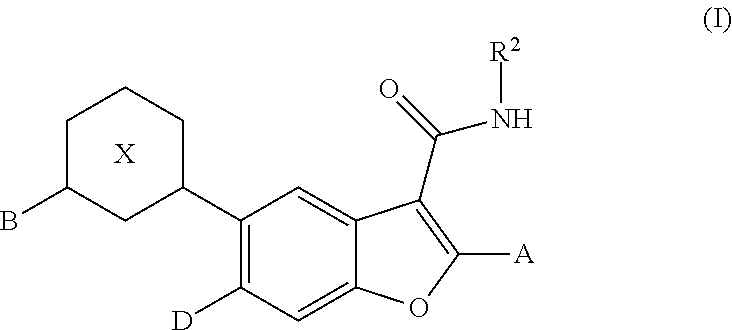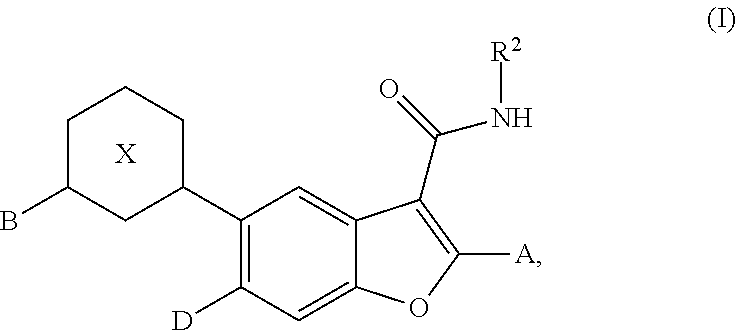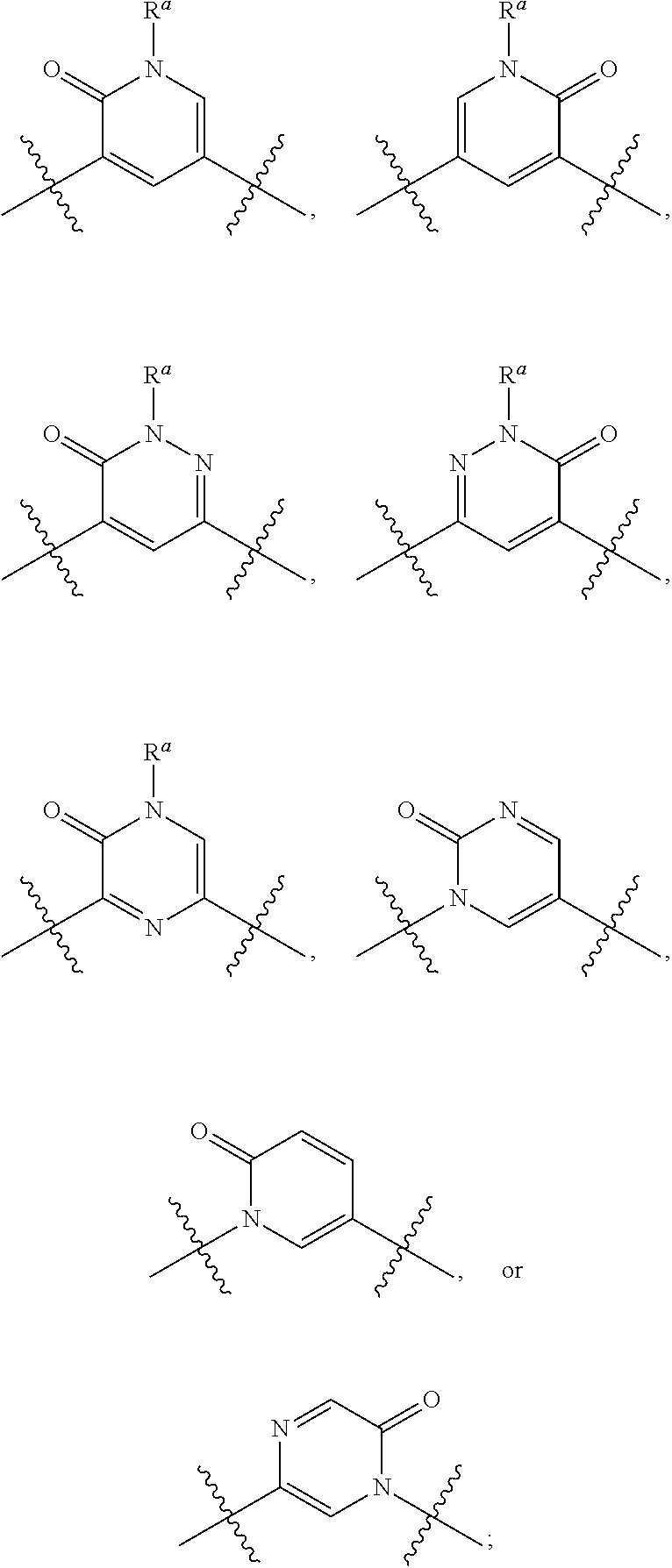Substituted benzofuran compounds and methods of use thereof for the treatment of viral diseases
- Summary
- Abstract
- Description
- Claims
- Application Information
AI Technical Summary
Benefits of technology
Problems solved by technology
Method used
Image
Examples
example 1
[0113]
Step 1—Synthesis of 2-(4-fluorophenyl)-N-methyl-5-(1-methyl-6-oxo-1,6-dihydropyridin-3-yl)-6-(N-methylmethylsulfonamido)benzofuran-3-carboxamide
[0114]
[0115]To a degassed solution of 2-(4-fluorophenyl)-N-methyl-6-(N-methylmethylsulfonamido)-5-(4,4,5,5-tetramethyl-1,3,2-dioxaborolan-2-yl)benzofuran-3-carboxamide (500 mg, 1.0 mmol) and 5-bromo-1-methylpyridin-2(1H)-one (281 mg, 1.5 mmol) in 1,4-dioxane (8 mL) and water (200 μl) was added CS2CO3 (486 mg, 1.5 mmol) and 1,1′-bis(di-tert-butylphosphino)ferrocene palladium dichloride (32 mg, 0.05 mmol) under N2 protection. The resulting mixture was heated to 80° C. and stirred at this temperature overnight. The reaction was cooled, filtered through a pad of the celite and washed with ethyl acetate. The combined filtrate was evaporated in vacuo. The resulting residue was purified using column chromatography (eluted with 0-100% EtOAc / hexane) to provide 2-(4-fluorophenyl)-N-methyl-5-(1-methyl-6-oxo-1,6-dihydropyridin-3-yl)-6-(N-methylmet...
example 5
[0121]
Step 1—Synthesis of 2-(4-fluorophenyl)-5-(5-iodo-1-methyl-6-oxo-1,6-dihydropyridin-3-yl)-N-methyl-6-(N-methylmethylsulfonamido)benzofuran-3-carboxamide
[0122]
[0123]To a screw cap vial was added 2-(4-fluorophenyl)-N-methyl-5-(1-methyl-6-oxo-1,6-dihydropyridin-3-yl)-6-(N-methylmethylsulfonamido)benzofuran-3-carboxamide (450 mg, 0.93 mmol) and NIS (419 mg, 1.86 mmol) in acetonitrile (5 ml). The vial was capped and microwaved at 80° C. for 20 min. The reaction mixture was evaporated in vacuo to remove the volatiles. The resulting residue was purified by column chromatography (eluted with 0-3% MeOH / DCM) to provide 2-(4-fluorophenyl)-5-(5-iodo-1-methyl-6-oxo-1,6-dihydropyridin-3-yl)-N-methyl-6-(N-methylmethylsulfonamido)benzofuran-3-carboxamide (290 mg, yield 51%). MS (M+H)+:610.
Step 2—Synthesis of compound 5-(5-(benzo[d]oxazol-2-yl)-1-methyl-6-oxo-1,6-dihydropyridin-3-yl)-2-(4-fluorophenyl)-N-methyl-6-(N-methylmethylsulfonamido)benzofuran-3-carboxamide
[0124]
[0125]To a solution of be...
example 6
[0126]
[0127]5-(5-bromo-1-methyl-6-oxo-1,6-dihydropyridin-3-yl)-2-(4-fluorophenyl)-N-methyl-6-(N-methylmethylsulfonamido)benzofuran-3-carboxamide (22 mg, 0.04 mmol), 4-fluoroisoindolin-1-one, Cs2CO3 (26 mg, 0.08 mmol) and Xantphos precatalyst (7 mg, 0.007 mmol) were combined with 1,4-dioxane (1.0 ml) in a sealed tube. The resulting mixture was heated to 90° C. and stirred for 2 h, then heated to 110° C. and stirred for additional 2 h. The filtration through a pad of the celite removed the solid. After washed with ethyl acetate, the combined filtrate was evaporated in vacuo. The resulting residue was purified by column chromatography (eluted with 0-5% MeOH / DCM) to provide 5-(5-(4-fluoro-1-oxoisoindolin-2-yl)-1-methyl-6-oxo-1,6-dihydropyridin-3-yl)-2-(4-fluorophenyl)-N-methyl-6-(N-methylmethylsulfonamido)benzofuran-3-carboxamide (13 mg, yield: 53%). MS (M+H)+: 633.
PUM
| Property | Measurement | Unit |
|---|---|---|
| Time | aaaaa | aaaaa |
| Force | aaaaa | aaaaa |
| Force | aaaaa | aaaaa |
Abstract
Description
Claims
Application Information
 Login to View More
Login to View More - R&D
- Intellectual Property
- Life Sciences
- Materials
- Tech Scout
- Unparalleled Data Quality
- Higher Quality Content
- 60% Fewer Hallucinations
Browse by: Latest US Patents, China's latest patents, Technical Efficacy Thesaurus, Application Domain, Technology Topic, Popular Technical Reports.
© 2025 PatSnap. All rights reserved.Legal|Privacy policy|Modern Slavery Act Transparency Statement|Sitemap|About US| Contact US: help@patsnap.com



